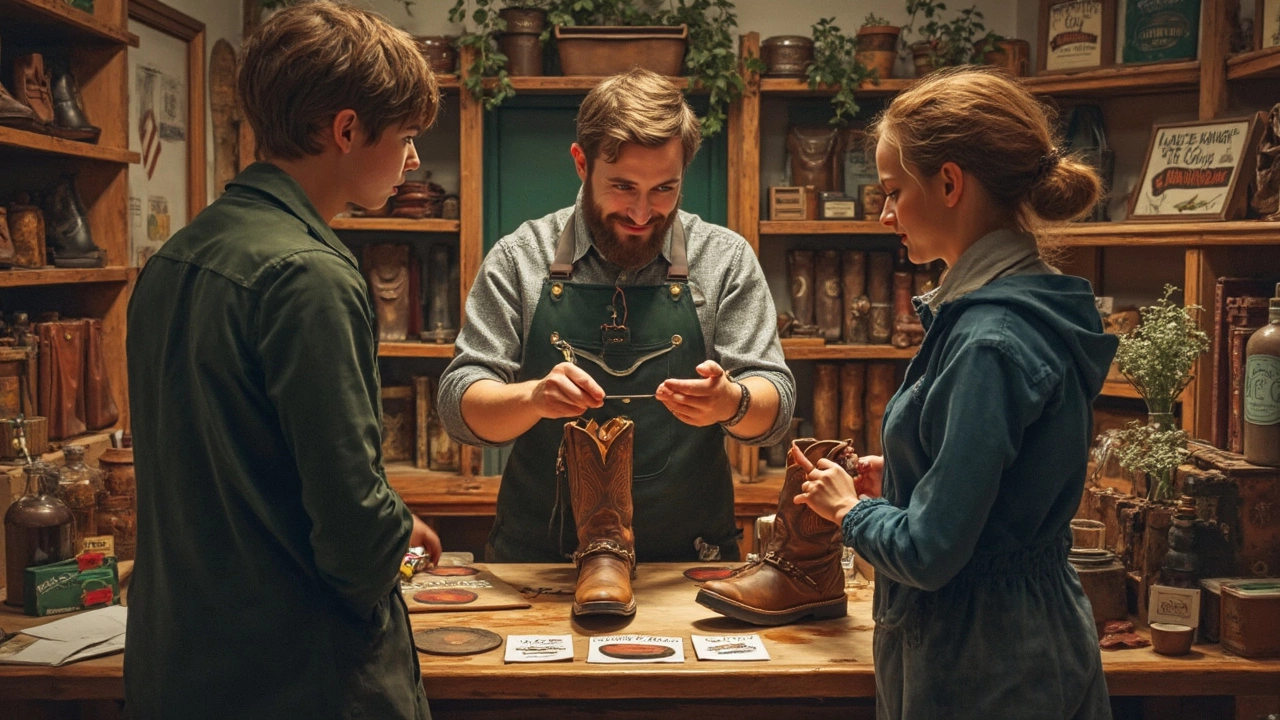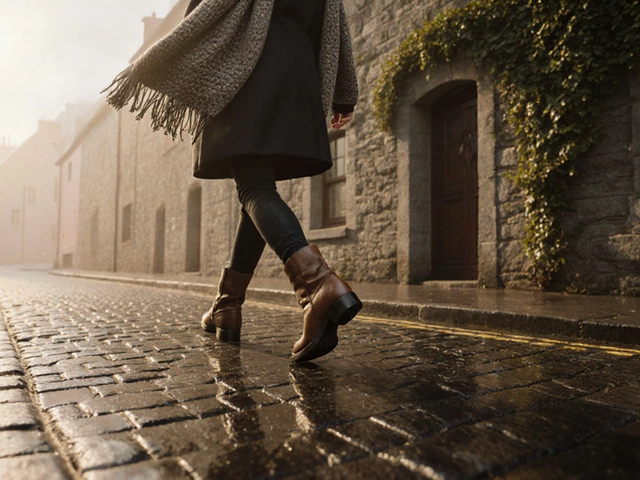Shopping for leather shoes in Ireland comes with a challenge: so many pairs look the part, but not all are the real deal. You might spot a label on a pair in a Galway boutique or an enticing discount at Dublin’s Jervis Shopping Centre. But before you splash out, do you really know what you’re buying?
Genuine leather has a texture you can actually feel—it’s never perfectly smooth or totally uniform. If you run your finger over the surface of a shoe and it feels too perfect, too plasticky, that’s your first red flag. Smell matters too. Real leather has a distinct, earthy scent—ask anyone who’s wandered into Dubarry’s flagship store in Ballinasloe. Synthetic materials rarely manage to copy it.
If you’re in a shop, press the material gently. If it wrinkles and forms little uneven lines, you’re likely holding real leather. Fake leather just dents or stays flat. In places like Cork’s English Market, staff know their materials, so don’t be shy—ask questions and get hands-on.
- Why Real Leather Matters in Ireland
- Simple Ways to Test for Genuine Leather
- What Local Shops and Markets Reveal
- Caring for Leather Shoes: Irish Weather Tips
Why Real Leather Matters in Ireland
Ask anyone in Ireland who’s spent a winter on the sideline at Croke Park or walked through Galway’s rain—shoes take a beating here. Quality matters, because cheap plastic just can’t stand up to Irish weather. Real leather shoes are famous for handling damp footpaths and surprise showers better than the fake stuff. They mold to your feet, let them breathe, and hold up for years, not just one season.
If you want something sturdy enough for those June festivals or winter strolls along the Liffey, genuine leather really does make a difference. You’re not just paying for the name; you’re getting a shoe that gets comfier with time, doesn't crack when soaked, and even shrugs off muck from GAA pitches or grassy walks at Phoenix Park.
Irish shoemakers have a strong reputation for quality. Dubarry, headquartered in Ballinasloe, ships their boots and shoes around the globe from the west of Ireland. They specialise in handcrafting leather footwear that’s not just stylish but can actually handle a puddle or two. Look out for other Irish brands too, like Lennon Courtney or Greenes Shoes, who often highlight where their materials come from, and why that matters for the Irish climate.
Treat it like an investment. Real leather shoes can be fixed again and again. Unlike synthetics, you're not forced to bin them after a few scuffs or a soggy commute. Irish cobblers—like those down by Francis Street in Dublin or in Cork city centre—can resole, refinish, and breathe new life into leather, saving you money year after year.
| Material | Longevity (Average in Ireland) | Weather Resistance | Comfort Over Time |
|---|---|---|---|
| Real Leather | 5+ years | High (with care) | Improves |
| Fake Leather | 1-2 years | Poor | Deteriorates |
In short, if you plan to step outside much in Ireland—which, let’s face it, you will—real leather pays for itself in the long run and makes daily life a whole lot more comfortable. That’s why Irish shoppers, and families like mine, wouldn’t settle for less.
Simple Ways to Test for Genuine Leather
If you’re on the hunt for real leather shoes in Ireland, it’s not about guessing or going by price tags alone. There are a few down-to-earth ways to make sure you’re getting the real thing, especially since fake leather is everywhere nowadays, even from shops that look reputable.
First up, the smell test. Real leather has an earthy, almost sweet aroma—think of that familiar scent when you walk past the leather stalls in St. George’s Market, Belfast. If it smells like plastic, glue, or chemicals, walk away. Synthetic shoes just can’t fake that warm leather scent, no matter how hard they try.
The second trick is to feel the leather. Run your thumb over the shoe and give it a gentle squeeze. Real leather will usually feel soft but sturdy. You might spot tiny pores or little wrinkles—nature doesn’t do perfect. Fake leather, or PU, always feels a bit too smooth or rubbery. If you press down on real leather, it will crinkle slightly, almost like skin. The fake stuff just dents or bounces right back, leaving no lines.
Don’t forget to check the edges of the material. With genuine leather, the edges look fibrous or rough. Synthetic shoes are usually sealed with a shiny, perfect edge—too perfect, really. Take a close look, especially when shopping at busy spots like Dublin’s Henry Street where you might get rushed into a decision.
Here are some quick tips you can use in any Irish shoe shop:
- Label Check: Genuine leather often has a “real leather” or “full grain leather” symbol—usually a small hide-shaped logo. But watch out: some labels are misleading. If you see “bonded leather” or “man-made upper,” you’re not looking at the real thing.
- Water Droplet Test: Put a tiny droplet of water on an inconspicuous spot. Real leather absorbs a bit and darkens. Fake leather usually lets the drop sit on top. (Don’t try this unless you’re sure the shop won’t mind.)
- Price Reality Check: Genuine leather shoes rarely sell for under €60 in Ireland, unless you’ve struck gold at a clearance sale. If it’s suspiciously cheap even at the likes of Penneys, it’s probably synthetic.
- Ask for Help: Irish shop assistants, especially those at longstanding cobblers or family shops, are usually honest and happy to explain the difference. If someone is cagey about the details, it’s a sign to move on.
Here’s a quick comparison between real and fake leather shoes you might find useful:
| Test | Real Leather | Fake Leather |
|---|---|---|
| Smell | Earthy, natural | Plastic, chemical |
| Texture | Irregular, pores visible | Smooth, uniform |
| Edges | Rough, fibrous | Shiny, flat |
| Water Absorption | Absorbs, darkens | Repels, no mark |
| Price (Ireland, avg.) | €60-€200+ | €20-€60 |
Nobody wants to pay full whack for shoes that will peel or crack after just a Donegal winter. Use your own senses, trust the evidence, and you’ll find it much easier to spot genuine leather on your next shopping trip.

What Local Shops and Markets Reveal
Walking around Ireland’s cities and towns, you’ll notice that different shoe shops and markets take their own approach to selling real leather shoes. Shops like Louis Copeland & Sons in Dublin, well-known for high-end men’s footwear, are transparent about where their leather comes from. If you’re down in Galway, Anthony Ryan’s has staff trained to explain exactly how their shoes are made and what type of leather is used. They don’t shy away from questions about tanning or dyeing processes.
The best thing about the Irish market is the access to independent retailers and family-run businesses. In smaller cities like Kilkenny, you’ll find places like Murphy’s Shoes, where owners can tell you the story behind nearly every pair on the shelves—whether the leather is from Italian, Spanish, or even locally tanned hides. In fact, Ballymena in Northern Ireland has a long tradition of leatherwork, so stores often carry shoes with regional pedigree labels. This means you can ask: where did the leather come from? How was it made?
Here’s how you can use Irish shops and markets to your advantage:
- Check for a leather symbol on the packaging—usually a little hide-shaped tag. Real leather will often show this. If you’re at a place like Brown Thomas, they’re strict about accurate labelling.
- Ask staff for details. Most reputable places in Ireland train their people to answer questions about sourcing and care. If someone avoids the question or seems unsure, that’s a warning sign.
- Feel the shoe. Markets in places like Ennis or Blackrock (in Cork) often have baskets of shoes for sale, some mixed in quality. Always touch and examine before buying.
- Look for country of origin tags on the inside or underneath. Ireland, Italy, Spain, and Portugal are major sources of quality leather shoes sold here.
One interesting fact: According to Bord Bia’s Leather Sector Report 2023, over 60% of Irish consumers said the top reason for choosing leather shoes was durability, while 55% cared most about where their shoes were made.
| Popular Irish Stores | Known For |
|---|---|
| Dubarry of Ireland | Premium waterproof and sailing leather shoes |
| Louis Copeland & Sons | High-quality men’s dress shoes |
| Anthony Ryan’s (Galway) | Detailed product knowledge and diverse brands |
| Murphy’s Shoes (Kilkenny) | Locally-sourced leather options |
| Kildare Village | Designer brands, labelled authenticity |
If you’re shopping in person, don’t hesitate to ask for proof. As John Tuohy, owner of Murphy’s Shoes in Kilkenny, puts it:
“People in Ireland value knowing exactly what they’re paying for—our regulars want to see, touch, and talk about the leather before buying. You can’t get that from an online photo.”
Markets and local shops are your chance to learn firsthand—and in Ireland, there’s always an expert willing to chat or show you the difference. That’s not something you get everywhere.
Caring for Leather Shoes: Irish Weather Tips
If you’re living in Ireland, you know the weather can flip from sunshine to sideways rain before you’ve zipped your coat. That’s murder on real leather shoes if you’re not careful. Unlike knock-off materials, genuine leather needs a bit of extra love to last, especially in our damp, unpredictable climate.
The main thing is keeping leather shoes dry and clean after a wet trek. Leave soggy shoes near (not right next to) a radiator or fire—cranking up the heat too close can dry them out and cause cracks. Stuff them with scrunched newspaper to suck out moisture faster and help keep their shape.
- Brush off dirt and grit after each wear, especially after city walks or a muddy stroll in Phoenix Park.
- Use a quality leather conditioner every few months. It’ll keep the leather soft and stop it from going stiff.
- For polish, try something Irish like Dubarry’s leather cream (handy in local shops or at Brown Thomas).
- If you’re planning a weekend in Donegal or a family trip to Connemara, bring spray-on waterproofing to help shoes handle heavy showers.
- Rotate your pairs, especially in winter. Give them a break between wears so the leather can recover.
The Central Statistics Office says Ireland gets an average of 150 rainy days a year. Here’s what that means for your leather shoes:
| Irish Region | Average Rainy Days/Year | Tip |
|---|---|---|
| Galway | 220 | Keep spare newspaper handy for drying shoes. |
| Dublin | 128 | Have leather spray at the ready for city bursts of rain. |
| Cork | 160 | Switch between pairs and let shoes fully air out. |
Never toss real leather shoes in the airing press thinking they’ll bounce back. The fastest way to ruin your investment is to dry them too quickly or forget about cleaning after a walk to the school gates. Give them just a little care and they’ll outlast most things in your wardrobe—dodgy weather or not.






Write a comment